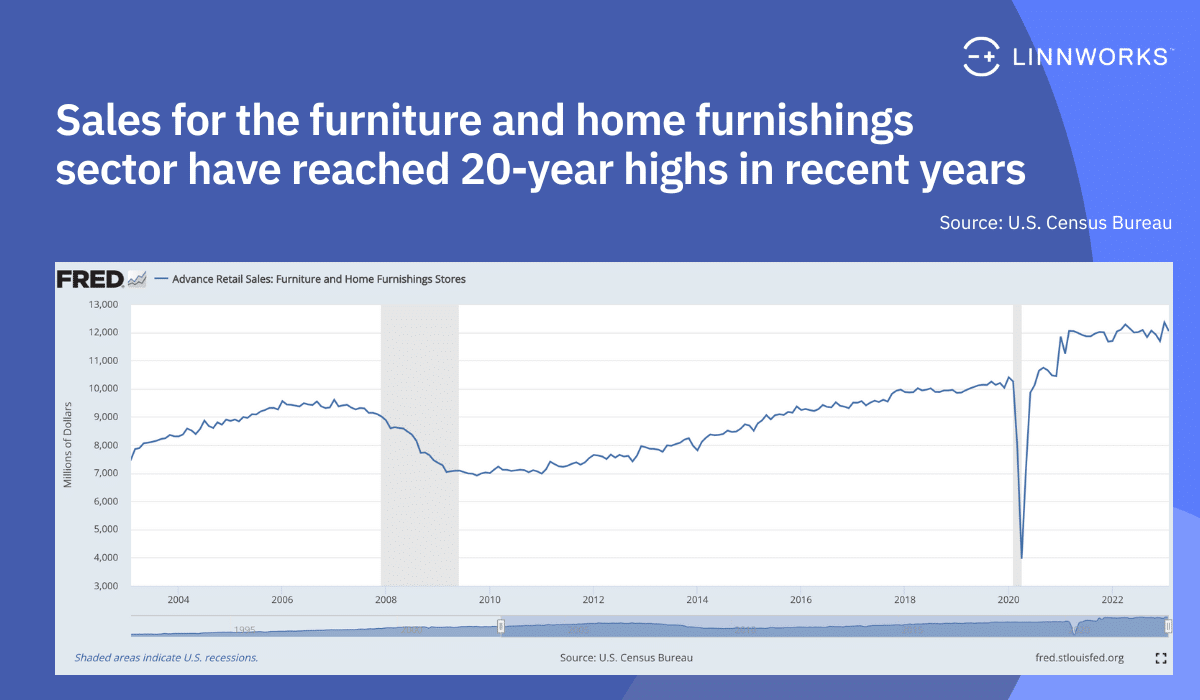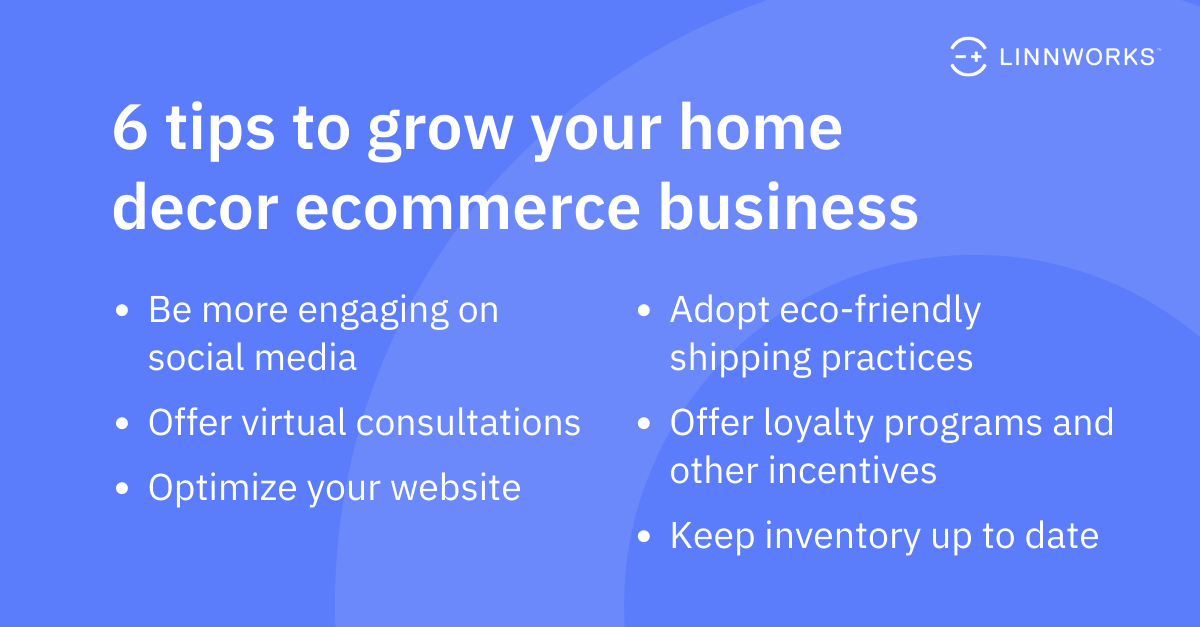6 best practices for growing a home decor ecommerce business in 2024
Home decor ecommerce has experienced wild fluctuations over the past few years.
When the pandemic forced many people to work from home, ecommerce home furnishing sales hit record highs. But companies that sell home decor online have also experienced massive supply chain disruptions, among other challenges.
While some areas of consumer spending have pulled back from pandemic highs, that’s less true in home furnishings. Advance retail sales for the furniture and home furnishings industry have been at 20-year highs during the past couple of years, according to the U.S. Census Bureau.
As consumers and retailers continue to emerge from the pandemic, home decor ecommerce businesses are looking to control costs, optimize operations and grow sales.
Learn six best practices that help these retailers deliver a great online shopping experience and grow their businesses.

The home decor ecommerce environment
Home decor is a broad category, covering everything from vases and artwork to furniture and other household items. One estimate placed the home decor market at $662.45 billion in 2022 with North America the leading region and Asia-Pacific the fastest-growing region.
While analysts expect the industry to continue to grow through 2026, there are challenges for these retailers. The pandemic was an unusual event that disrupted shopping patterns and generally favored ecommerce retailers. But the gains from that period are abating in many sectors, even if sales remain above pre-pandemic levels.
Another significant challenge for home decor retailers is volatility in the housing market, particularly in the U.S. Home sales have slowed amid high home prices and soaring mortgage rates. According to the National Association of Realtors, median prices for existing homes surpassed $400,000 for the first time during 2022 while mortgage rates reached 20-year highs in late 2022.
These factors, combined with economic uncertainty, changing consumer preferences and sustainability concerns, are among the trends retailers need to watch.
6 tips for growing your home decor ecommerce business
Industry-specific challenges for ecommerce home decor companies include competition from big-box chains and local retailers, fluctuating consumer demand and housing affordability. Even with those challenges, however, retailers can thrive with the right strategy.
Here are six tips for selling home decor online more effectively.
Optimize your website
Your website is often the first point of contact with potential customers, and it needs to provide a modern and user-friendly experience. Start by testing website functionality, including whether it’s mobile friendly.
One way to make your website more attractive is by helping customers visualize what their purchase will look like. This is where augmented reality (AR) and virtual reality (VR) tools can make your product pages shine. For example, IKEA Place is an app that allows shoppers to select a product and virtually “place” furnishings in their home. Shoppers can make more informed decisions, and they see that IKEA prioritizes more than quick sales.
VR in ecommerce can combine with marketing to get customers excited about the purchase. And because they can see the product more clearly, they’re less likely to make returns.
Ensure your website offers the latest customer support tools, including interactive chat. Live chat can be valuable at any stage of the sales cycle, not just when something’s gone wrong. Guides, blog posts and other educational material can offer meaningful information and help answer common questions.
Optimizing your website for search is critical for attracting people who shop online. Search engine optimization (SEO) is a key component of ecommerce marketing strategies. Make sure your pages are optimized for SEO, including in the page titles and meta descriptions. This will make it easier for potential customers to find your website when they’re searching for home goods.
Offer virtual consultations
Virtual consultations are increasingly popular in home decor, especially during the pandemic when in-person consultations weren’t always possible. Virtual consultations get your customers personalized design advice and recommendations wherever they are, making the shopping experience more convenient and accessible.
You can use videoconferencing tools (such as Zoom and Google Meet) and messaging apps (including WhatsApp and Facebook Messenger) to connect experts with customers. You can offer these consultations for free or as upselling opportunities — just make sure you have the staff and in-house expertise to meet the demand.
Implement eco-friendly shipping practices
Many customers are rightfully concerned about the long-term impact of their purchases on the environment. Appeal to the most environmentally conscious consumers by implementing eco-friendly shipping practices, which can also be a competitive differentiator and even save money in your supply chain.
Going green takes many forms. Examples include reducing packaging waste and partnering with carbon-offset projects to cut the impact of emissions from shipping and delivery.
You can also help consumers choose eco-friendly options through incentives. You might offer discounts, reward points or exclusive offers for customers who choose these options. Other consumers appreciate it when companies donate a portion of their sales to organizations that promote sustainability.
Another effective approach is using a decentralized warehousing model. By strategically locating warehouses closer to customers, companies minimize shipping distances and reduce their carbon footprint. This model also allows companies to manage inventory and logistics more efficiently, which saves time and money.
Efficient and error-free shipping processes are another crucial area of sustainable ecommerce. Shipping is often the biggest contributor to emissions. Look for solutions such as Linnworks that help businesses become more eco-friendly by tracking and managing inventory, orders and shipping.
Offer loyalty programs and other incentives
One way to encourage customers to continue buying from you is with incentives, including returning-customer discounts and free shipping.
Consider a customer loyalty program to reward repeat shoppers. These programs usually involve some sort of point-based or spending-based system with redemptions for discounts or other rewards. Customers are incentivized to make additional purchases and turn to your brand when they have new home decor needs.
Another incentive to consider is early or exclusive access to new products for segments of your customer base. Perhaps you target customers who spend a certain amount, sign up for an email list, or buy home decor items in the same category or from the same brand. Not only does the business gain valuable data on customer interests, but shoppers also get excited about the exclusive opportunities.
Many retailers offer free shipping for orders of a certain size. This can be an effective way to increase average order size. At the least, it puts your business on equal footing with retailers like Amazon, Target and Walmart.
Be more engaging on social media
Social media is a particularly powerful tool in ecommerce, as home decor shoppers seek inspiration and ideas from platforms like Instagram and Pinterest. Let your followers know what’s new with your business, including new products. Make sure you use high-quality photos and videos and compelling captions and hashtags.
Platforms such as Facebook, Instagram, and Pinterest have powerful ecommerce capabilities, adding a direct way to sell to followers without them having to leave the app. Selling on Instagram and other platforms helps businesses create an authentic ecommerce experience directly rather than simply listing on platforms such as Facebook Marketplace.
One of the key features of selling on social media is the ability for brands to tag and promote products within their social media posts. For example, on Instagram, businesses can tag their products in their posts and stories, allowing customers to tap the product and see more details, including price and product description.
Do more than just try to sell. Run polls and other interactive content, and respond to comments and messages promptly and thoughtfully. By communicating with your followers, not just at them, businesses foster brand community and build deeper relationships. User-generated content can also be a powerful organic marketing vehicle that you can leverage for promotions, such as unboxing videos or product reviews.
Finally, consider how social media influencers and brand ambassadors can add another level of promotion and reach for your products. These individuals have direct, trusting relationships with their followers. Their promotion of your products will be more authentic and relatable than if you ran an advertisement at those same consumers.
Keep inventory up to date
Inventory management is crucial to get right in ecommerce, and especially so in high-demand industries like home decor. Customers in the effortless economy want to find and buy products without any hiccups — and they want them quickly, especially for seasonal home decor. If you don’t have the product they want or can’t fulfill it properly, they’ll go to a competitor.
One of the most effective ways to stay on top of your inventory is to use an inventory management system, such as Linnworks. These systems help you track, manage and optimize your inventory and avoid stockouts from high demand. This can also help you identify and solve for slow-moving products so you don’t waste money and resources.

Control your growth with Linnworks
Controlling growth is just as important as growing the business. As your home decor ecommerce business expands, you’ll need to streamline operations, manage inventory more efficiently and automate key processes to keep up with demand.
Linnworks is a modern ecommerce platform that can help you manage all of your operations from a centralized dashboard. By automating these key tasks, you can reduce errors, save time and focus on growing your business.
With Linnworks, you can also access advanced reporting and analytics for making data-driven decisions and optimizing your operations. As you implement these best practices and continue to grow your business, Linnworks can help you scale effectively and sustainably.
Managing your ecommerce operations effectively is key to growing revenue, delighting customers and avoiding overselling.
Learn how a home and garden retailer, Rinkit, uses Linnworks to prevent stockouts for their business.